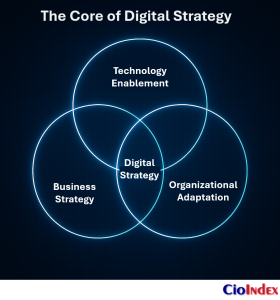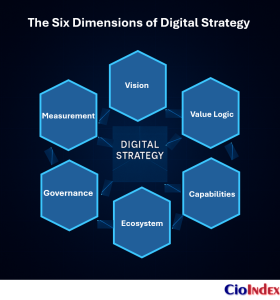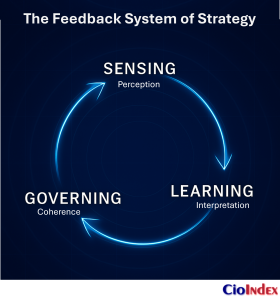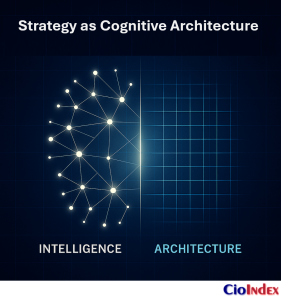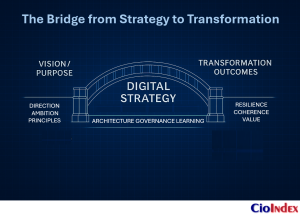The Missing Blueprint of the Digital Age
Technology has never been more pervasive, yet organizational direction has rarely felt less certain. At the center of this confusion lies digital strategy — the missing blueprint of the digital age. Enterprises automate, migrate, and experiment at scale, but few can explain how these activities connect. According to recent executive surveys, fewer than one in three large organizations report that their digital initiatives are guided by an integrated strategy. The rest operate through fragmented plans—each valid in isolation but incoherent in combination—a mosaic of projects without design.
The assumption that digital transformation naturally produces strategy has proved mistaken. Transformation describes change; strategy defines intent. Without strategy, transformation becomes a sequence of reactions—new tools, new platforms, new investments—uncoordinated in purpose. What’s missing is the structural logic that translates ambition into architecture: the design through which a digital enterprise knows what to build, why to build it, and how its parts reinforce one another.
The consequences of that absence are visible in performance. Some of the most aggressive technology adopters have underdelivered precisely because their digital investments lacked coherence. General Electric’s attempt to reinvent itself as a “digital industrial company” showed the cost of scaling activity faster than design. Walmart, by contrast, built its reinvention on a disciplined strategic backbone—integrating data, logistics, and omnichannel experience around a single operating model. The distinction lies not in technology but in architecture: one pursued transformation as a declaration, the other as a system.
A digital strategy does not chase technology; it designs the enterprise as a dynamic system. It defines the architecture through which purpose becomes capability and capability becomes value. It is not a roadmap or a list of initiatives but a living framework that determines how an organization learns, scales, and differentiates. Where traditional strategy sought advantage through market position, digital strategy seeks advantage through structural design—the pattern of connections that allows the enterprise to evolve continuously.
The most resilient organizations exhibit architectural clarity—a property consistent across industries and scales. Each digital investment reinforces a shared design principle, ensuring that technology, data, and decisions interlock. They treat digital strategy as the connective tissue between disruption and reinvention—the framework that converts technological possibility into institutional capability. Disruption supplies the force; digital business defines the form; digital strategy provides the framework that binds them.
This triad—disruption, strategy, and business—forms the logic of enterprise reinvention. Together they describe not a sequence of steps but an interdependent system. Strategy sits at the center of that system as the blueprint of organizational design—the structure through which technology becomes advantage and transformation becomes deliberate.
Defining Digital Strategy — Beyond IT and Innovation
Most enterprises still treat digital strategy as an extension of technology planning. They describe it in terms of platforms to deploy, processes to automate, or data to analyze. These are operational decisions, not strategic ones. A true digital strategy does not begin with technology; it begins with design — the intentional structuring of how an enterprise creates and renews value through digital means.
Technology, in this view, is not the strategy but the material of strategy. Cloud, data, automation, and AI become architectural components within a broader system of intent. The purpose of digital strategy is to orchestrate these components so that they reinforce one another, producing coherence rather than accumulation. Its aim is to turn technological capability into organizational advantage.
A precise definition follows from that distinction:
Digital strategy is the deliberate design of an enterprise’s competitive logic, capabilities, and ecosystems through digital means — aligning purpose, technology, and transformation into one coherent architecture.
Three imperatives define this architecture.
Alignment ensures that every digital initiative expresses the organization’s intent. It connects the strategic horizon — why the enterprise exists and where it competes — with the operational realities that shape its execution. Without alignment, digital activity becomes noise: projects multiply but purpose fragments.
Integration unites the structural layers of the enterprise. Business strategy, operating model, and technology stack must function as one system, each informing and constraining the other. Integration creates continuity across the architecture — the ability for data, processes, and decisions to move coherently through the organization.
Adaptability sustains that coherence under change. Digital strategy is not fixed; it evolves as conditions shift. The most effective strategies build learning directly into their architecture — feedback loops, modular design, and governance that can sense and respond without destabilizing the whole.
Alignment, integration, and adaptability define the structural logic of digital strategy — the point where design replaces aspiration. They explain why enterprises with similar tools achieve radically different outcomes. The difference lies in architecture, not access. The difference is evident in enterprises that have rebuilt their architecture around coherence.
PepsiCo’s collaboration with AWS reframed its operating logic around agility. Data from manufacturing, logistics, and retail now flow through a unified cloud backbone that informs real-time decisions. The result is not just operational efficiency but structural responsiveness — the ability to anticipate demand rather than react to it.
At Ferrari, the fusion of racing telemetry with AI-driven analytics has turned performance data into a strategic interface with fans and partners. What began as engineering optimization evolved into an ecosystem model — a seamless connection between product, experience, and brand.
DocuSign’s reinvention as an Intelligent Agreement Management platform applies the same architectural principle in a different context. Information once confined to contracts now circulates as operational intelligence across business systems. The enterprise did not digitize paperwork; it redefined agreements as data flows, embedding value where friction once existed.
These examples reveal a consistent design law: coherence precedes capability. Their success lies less in the sophistication of their technology than in the precision of their design. Digital strategy begins not with what an enterprise adopts, but with how it intends to connect — aligning ambition, architecture, and adaptation into a single structural logic.
The Evolution of Digital Strategy
Strategy has always mirrored the dominant logic of enterprise design. When advantage depended on control, organizations mastered scale, standardization, and supply. They were built as machines: efficient, repeatable, and predictable. As advantage shifted toward differentiation, success required the ability to sense markets, analyze data, and act faster than competitors. Enterprises evolved into systems of processes and analytics, optimized for speed rather than mass.
Digital strategy represents the next evolution of that logic. Advantage now stems from adaptive architecture — the capacity of an organization to learn continuously, connect dynamically, and evolve without losing coherence. Traditional strategy assumed stability; digital strategy begins from volatility. It recognizes that success depends less on what an enterprise controls than on how it orchestrates relationships — between data and decisions, systems and people, customers and ecosystems. Control has yielded to connectivity, prediction to learning, and competition to orchestration.
This shift has redefined what it means to design a strategy. The task is no longer to predict and plan but to architect for learning and recombination. The enterprise becomes a living system — one that senses change, interprets it, and reconfigures itself in response. Digital strategy functions as that adaptive blueprint: a mechanism for coherence under constant flux.
| Strategic Logic | Dominant Aim | Source of Advantage | Design Principle | Representative Example |
|---|---|---|---|---|
| Control | Efficiency through replication | Scale and standardization | Mechanistic architecture | General Motors |
| Differentiation | Responsiveness through data | Process optimization | Analytical architecture | IBM |
| Connectivity | Continuous learning and orchestration | System intelligence | Adaptive architecture | Amazon / Tesla / Apple |
Modern exemplars embody this progression. Amazon operates less as a retailer than as a continuously learning architecture — every process instrumented, every decision enriched by feedback. Its strength lies not in scale but in the precision of its learning loops. Tesla applies a similar logic to manufacturing: software updates, telemetry, and customer data form an adaptive circuit linking product and organization. Apple converts integration itself into a discipline, treating ecosystem design as strategy.
These enterprises compete through systems, not structures. Their strategy is inseparable from the architecture that enables it. Where earlier models of advantage depended on control, digital strategy depends on connection — a form of intelligence distributed through the enterprise rather than concentrated at the top.
The implication is fundamental. Digital strategy does not replace classical strategy; it reframes its assumptions. Planning gives way to sensing, positioning to orchestration, efficiency to adaptability. Strategy is no longer a document of intent but an architecture of learning — a system designed to evolve.
Anatomy of a Digital Strategy
A digital strategy is the structural design that gives transformation its direction and coherence — the architectural logic through which purpose, capability, and governance converge into performance. It functions as a system of intent, design, and measurement that shapes how the enterprise learns, decides, and evolves. Its anatomy can be observed through six structural dimensions: vision and intent, value logic, capabilities, ecosystem, governance, and measurement. These are not sequential stages but interdependent components that hold the enterprise together. When aligned, they create coherence; when fragmented, they produce drift.
Vision and Intent
Every digital strategy begins with a deliberate view of purpose — why the enterprise seeks transformation and what kind of organization it aims to become. Vision translates aspiration into structure. It defines not only desired outcomes but the principles that determine how value will be created. Microsoft’s cloud-first, AI-first orientation, for example, was not a slogan but a redesign of corporate intent that reoriented investments, leadership, and operating rhythm around continuous reinvention.
Value Logic
Strategy exists to create advantage, and digital strategy redefines how advantage is constructed. It asks not only what value is delivered but how value is generated and renewed through digital means. The shift from product to platform, from transaction to ecosystem, and from ownership to experience all stem from a redesigned value logic. DocuSign’s evolution from e-signature utility to Intelligent Agreement Management platform illustrates this transformation: value now arises from data circulation and integration, not from individual transactions.
Capabilities
Capabilities translate intent into capacity. In a digital enterprise, this means combining human expertise, data, and technology into repeatable patterns of performance. Capabilities are both technical and organizational — the ability to sense, decide, and act in concert. Schwarz Digits’ expansion of sovereign cloud services across industries demonstrates how capability architecture becomes a form of strategy: expertise in data sovereignty and AI infrastructure has evolved into a scalable competitive asset.
Ecosystem
No enterprise competes alone. Digital strategy extends advantage through networks of partners, platforms, and shared data systems. The goal is not control but orchestration — aligning incentives and interfaces so that value compounds across participants. Broadridge’s integrated ecosystem of fintech partners, regulators, and clients shows how an organization can treat compliance and innovation as a single connected design. In a digital economy, ecosystems are not adjuncts to strategy; they are its medium.
Governance
Coherence depends on how decisions are made and measured. Governance provides the logic by which priorities are set, risks balanced, and learning institutionalized. Johnson & Johnson’s realignment of its AI portfolio demonstrates governance as strategic discipline: by concentrating investment in high-impact domains and curbing exploratory sprawl, the company turned experimentation into a governed system of value creation. Digital governance is not bureaucracy; it is the architecture of choice.
Measurement
What organizations measure reveals what they manage. In digital strategy, metrics must capture not only outcomes but adaptability — the enterprise’s capacity to learn, scale, and sustain value over time. Traditional ROI is too static; digital measurement integrates velocity, resilience, and integration as indicators of strategic fitness. Microsoft’s transformation scorecards and Adobe’s engagement-driven KPIs both reflect this shift from performance snapshots to continuous sensing.
When these six dimensions reinforce one another, digital strategy becomes a living structure. Vision defines purpose; value logic gives it economic coherence; capabilities operationalize it; ecosystems extend it; governance stabilizes it; and measurement evolves it. The strength of the system lies in the interconnection — each component both constrains and enables the others. Coherence, not scale, is the truest measure of maturity.
| Dimension | Strategic Function | Architectural Question | Illustrative Case |
|---|---|---|---|
| Vision & Intent | Defines purpose and direction | What future are we designing for? | Microsoft |
| Value Logic | Reconstructs how value is created and renewed | How does digital redefine our advantage? | DocuSign |
| Capabilities | Converts design into repeatable capacity | What can the enterprise consistently do? | Schwarz Digits |
| Ecosystem | Extends advantage through collaboration | Who amplifies our value and how? | Broadridge |
| Governance | Aligns decisions and accountability | How do we sustain coherence under change? | Johnson & Johnson |
| Measurement | Assesses adaptability and progress | How do we know the strategy is learning? | Microsoft / Adobe |
A digital strategy, viewed through this architecture, is less a document than a design system — a living framework through which the enterprise sustains alignment between ambition and execution. Its anatomy reveals not only what the organization intends to achieve but how it is structured to evolve.
The Operating Logic of Digital Strategy
Digital strategy functions as the coordinating intelligence of the enterprise — the structural system through which adaptation occurs. It connects perception, interpretation, and decision into one continuous flow, translating change in the environment into coherent organizational response. Through this system, the enterprise maintains stability while evolving; it governs transformation not by control but by design.
Within this architecture, sensing, learning, and governing form a single loop of adaptation.
Sensing provides perception. Data architectures, telemetry, and analytics form the enterprise’s sensory field, allowing it to register movement in markets, operations, or behavior before those shifts materialize in outcomes. In a digital enterprise, awareness is not a function of reporting but an inherent property of structure.
Learning provides interpretation. Information gains value only when absorbed into design logic — when the organization can convert feedback into new principles of operation. Structures that embed experimentation, measurement, and reflection turn adaptation from reaction into capability. Amazon’s decentralized model illustrates this systemic learning: each unit experiments within defined parameters, contributing to collective intelligence rather than isolated improvement.
Governing provides coherence. As sensing and learning distribute throughout the organization, strategy must ensure that adaptation remains aligned. Governance, in this sense, is not administrative control but structural discipline — the logic by which priorities, risks, and feedback converge into unified direction. Unilever’s integrated decision and performance systems exemplify governance as architecture: financial, strategic, and sustainability metrics are interlinked, allowing decisions to remain both autonomous and coordinated.
This logic is not confined to information flow; it becomes structure.
Sensing, learning, and governance align across three interconnected layers — strategic intent, operational capability, and enabling infrastructure. Strategy functions not as an overlay but as the architecture that binds these layers into one adaptive system.
These mechanisms do not operate in sequence; they reinforce one another continuously. Sensing generates information; learning transforms it into design; governance translates it into decision. Together they constitute a feedback architecture — a living circuit of awareness and action. Through this loop, digital strategy enables the enterprise to govern its own evolution.
The significance of this logic extends beyond internal operation. Disruption provides the stimulus, transformation the structural response, and digital business the living form that results. Strategy binds them together — the system through which the enterprise perceives, interprets, and evolves as one. It is no longer the blueprint of transformation but its nervous system: the architecture through which the enterprise learns to adapt with intention and coherence.
The Future of Strategizing — From Planning to Cognitive Architecture
The discipline of strategy is undergoing structural change. Organizations are beginning to operate their strategies through intelligent systems rather than static plans. Decision cycles are compressing, sensing infrastructures are expanding, and machine learning is becoming an integral part of enterprise governance. The shift is uneven but unmistakable: strategy is evolving from an act of planning into an architecture of cognition.
This transformation is visible in the way leading enterprises design and operate their strategic systems.
Shell’s Energy Security Scenarios platform functions as a dynamic digital twin of global energy markets, continuously recalibrating assumptions about supply, demand, and policy. Unilever’s enterprise data architecture links sustainability, performance, and investment metrics into a single feedback structure that informs decisions across functions. Siemens and Airbus employ digital-twin environments not only to optimize operations but to model strategic trade-offs before they reach the boardroom. In 2024, BP extended its partnership with Palantir to build AI-enabled twins that integrate production data with macroeconomic variables, turning its operational architecture into a live strategic simulation layer. And DBS Bank, recently profiled by Harvard Business School, has embedded AI and data-driven decision logic into its governance model, enabling the institution to learn and steer in real time.
These examples do not represent experiments on the fringe of management practice; they mark the emergence of a new strategic infrastructure — what can be described as cognitive architecture.
Cognitive architecture refers to the structural convergence of data, intelligence, and governance into one system of strategizing. In this system, architecture is not a static foundation but a living substrate that perceives its environment, interprets information, and reorganizes itself through feedback. AI-driven analytics, simulation models, and decision frameworks form the enterprise’s cognitive layer. Strategy no longer acts upon these systems; it operates through them.
This convergence redefines the strategist’s work. Instead of designing plans for execution, leaders design the systems that generate and validate strategic insight. Advantage increasingly depends on how effectively human judgment and machine learning are integrated — how organizations build interfaces between intuition and computation. In this environment, the strategist becomes an architect of cognition: curating data flows, feedback loops, and governance logic so that the organization can learn as it acts.
The implications extend beyond technique to the philosophy of management itself. Digital strategy becomes recursive — it shapes the structures that shape decisions. As strategy, architecture, and intelligence merge, the enterprise gains the capacity to think about its own thinking. It can simulate outcomes, test assumptions, and evolve its design logic continuously. The practice of strategy thus shifts from prediction to perception — from charting the future to constructing the system that perceives it first.
What distinguishes the most advanced organizations is not their technology but their ability to institutionalize this learning architecture. Strategy becomes a form of organizational intelligence: a living system that connects awareness, judgment, and adaptation into one coherent design.
Measuring Digital Strategy — From KPIs to Strategic Fitness
The effectiveness of a digital strategy cannot be captured through traditional performance reporting. Metrics built for industrial predictability or quarterly efficiency fail to describe a system designed for continuous adaptation. KPIs measure events; digital strategy must measure capabilities of response. What matters is not the return on a single initiative but the enterprise’s ability to remain coherent and effective under volatility.
Strategic Fitness expresses this principle. It is the enterprise’s capacity to sustain coherence, performance, and learning as conditions change — the dynamic equilibrium between speed, stability, integration, and impact. Traditional KPIs track outcomes; fitness metrics evaluate resilience in motion: how the strategy sustains alignment and learning while evolving.
Four dimensions define strategic fitness.
Velocity — The Speed of Learning and Execution
Velocity measures how quickly the enterprise converts signal into action. In digital organizations, responsiveness depends on feedback density, not headcount. Microsoft’s transformation scorecards illustrate this: each business unit tracks cycle-time indicators showing how rapidly telemetry and customer insight translate into operational change. Velocity represents strategic metabolism — how fast a design learns.
Resilience — The Capacity to Absorb and Reconfigure
Resilience evaluates how a strategy performs when conditions deviate from plan. ING’s agile-maturity metrics assess structural resilience — the bank’s ability to redirect resources, reprioritize portfolios, and maintain continuity under stress. Resilience is measured not by avoidance of disruption but by how constructively the system recomposes itself in response.
Integration — The Coherence of the Whole
Integration captures the degree to which initiatives reinforce rather than fragment one another. Broadridge’s adaptability metrics provide a practical example: regulatory, technological, and client-facing changes are assessed through a single integration index that tracks alignment across functions. High integration means the architecture behaves as one organism; low integration signals drift and duplication.
Impact — Transformation Outcomes Over Time
Impact remains essential but redefined. It is measured not solely through financial return but through enduring transformation outcomes — productivity, relevance, sustainability, and cultural change. BCG’s 2025 energy-sector benchmarks use this multi-dimensional view: grid modernization programs are evaluated for financial performance, carbon resilience, and ecosystem value creation. Impact therefore reflects strategic consequence, not short-term output.
These four dimensions operate in tension and balance. Velocity without integration fragments effort; resilience without impact breeds stagnation; integration without velocity suppresses innovation. Strategic fitness lies in maintaining equilibrium among them — a dynamic balance of speed, structure, and significance.
| Dimension | Definition | Indicative Metrics | Illustrative Case |
|---|---|---|---|
| Velocity | Speed of learning and execution | Cycle-time to decision; time-to-deploy insight | Microsoft |
| Resilience | Capacity to absorb and reconfigure under stress | Resource-reallocation rate; continuity index | ING Bank |
| Integration | Coherence across initiatives and functions | Cross-initiative alignment score; data-integration ratio | Broadridge |
| Impact | Long-term transformational outcomes | Transformation index; sustainability ROI | Energy Sector (BCG 2025) |
Strategic fitness reframes measurement as part of the architecture itself. Each dimension functions as feedback: velocity reveals learning speed, resilience shows systemic strength, integration tests coherence, and impact demonstrates purpose realized. As in the sensing–learning–governing loop described earlier, measurement closes the circuit — transforming performance data into strategic learning. Together these signals create a diagnostic of strategic health — a live gauge of how well the enterprise’s design logic endures in motion.
When organizations measure fitness rather than activity, metrics become instruments of learning, not judgment. Digital strategy evolves from a target to hit into a system that senses its own effectiveness — a self-measuring architecture capable of sustaining direction through change. In volatility, strategic fitness becomes the enduring advantage — the ability to keep learning faster than the environment evolves.
From Digital Strategy to Enterprise Transformation
Transformation is often described as a journey, but it is better understood as a design that changes its own designer. Strategy is that design. It does not sit outside transformation; it determines how transformation takes form, how momentum is sustained, and how value is created beyond the initial wave of change. Transformation without strategy is motion without direction; strategy without transformation is intent without impact.
Digital strategy functions as the architectural bridge between vision and realization — the connective structure through which intent becomes enterprise behavior. The coherence of this bridge determines whether transformation compounds or collapses. When digital strategy operates as a system of alignment, learning, and governance, it translates aspiration into operational truth.
The logic is visible wherever transformation becomes structural rather than episodic. UPS’s logistics network is not a project but an evolving architecture: IoT, AI, and predictive routing unified into a single data fabric that continuously optimizes efficiency, sustainability, and service. The system connects purpose, capability, and outcome in one loop of learning. Transformation here is not achieved and archived; it is continuously recomposed by design.
Nvidia follows a similar architecture of coherence. Across hardware, software, and AI ecosystems, the company’s strategy operates as an integrated logic of accelerated computing. Each product, partnership, and platform reinforces this structural rhythm. What began as component manufacturing has matured into a system-level orchestration of innovation — transformation expressed as ecosystem intelligence.
At PepsiCo, coherence has been institutionalized as capability. Its digital backbone connects supply, analytics, and brand operations into a shared learning infrastructure. The same architecture that accelerates demand sensing also enables experimentation in sustainability and customer relevance. Transformation becomes a reflex of the enterprise — an adaptive property, not a periodic event.
The endurance of transformation depends less on technology than on the continuity of design logic. Leadership transitions, market shocks, and policy shifts test whether that logic persists. The most mature organizations embed coherence in their operating cadence: strategic architecture becomes a governance mechanism, not an initiative.
Enterprises that sustain transformation treat design itself as a capability. UPS’s logistics intelligence, Nvidia’s ecosystem logic, and PepsiCo’s adaptive enterprise share a structural trait — each is strategically fit: capable of recomposing its own coherence under pressure. Success is measured not by the speed of change, but by the stability of learning.
Transformation, in structural terms, is the visible consequence of an invisible discipline. A coherent digital strategy creates a system that continually renews itself — absorbing, adapting, and realigning without losing identity. The enterprise becomes a living design: transformation is no longer managed, but maintained through architecture.
The Blueprint Mindset
Digital strategy is not a plan of action but a pattern of intelligence — the architecture through which an enterprise learns to adapt by intention, not inertia. It unites vision and behavior, technology and purpose, decision and learning. What it creates is not certainty but coherence: the condition in which a system can evolve without losing itself. Enterprises that master this pattern no longer chase transformation; they internalize it. Change becomes their steady state, and design becomes their language of continuity.
The blueprint mindset reflects this maturity. It treats structure as a living system and strategy as its consciousness — a way for the organization to think about its own evolution. Leadership, in this view, is not the authority to decide but the responsibility to design decisions that keep learning alive. Governance becomes less about oversight and more about preserving the integrity of intelligence.
At its most advanced, digital strategy becomes indistinguishable from organizational awareness. It is the mechanism through which disruption becomes design and business becomes intelligence — a continuous loop of sensing, shaping, and sustaining. The enterprise that achieves this state no longer manages transformation; it embodies it.
Enduring advantage will belong to those who understand this shift. Tools will converge and technologies will commoditize, but coherence — the ability to stay whole while changing — will define longevity. The blueprint mindset is not a metaphor for planning; it is a discipline of renewal — the design logic of intelligence itself.

